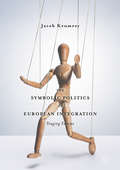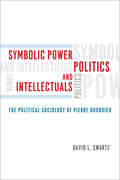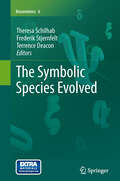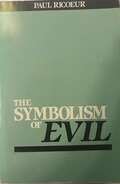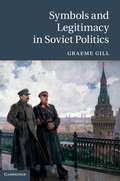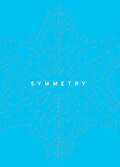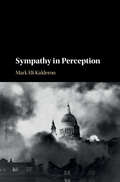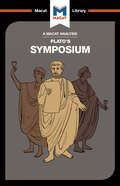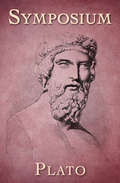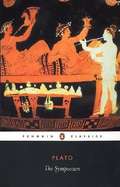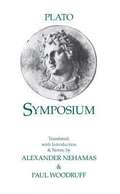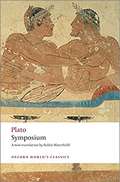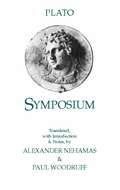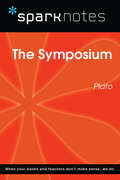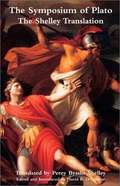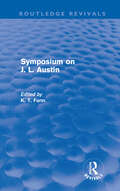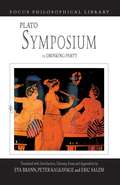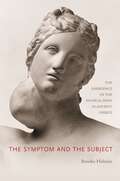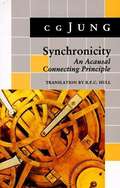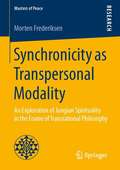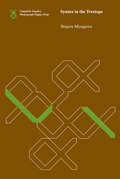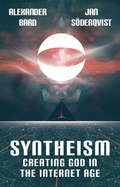- Table View
- List View
The Symbolic Politics of European Integration
by Jacob KrumreyThis book presents a cultural history of European integration. It revisits the European Community’s postwar origins through the lens of symbolic representation and so reveals a hitherto unknown side to Europe’s notorious technocrats. They were not simply administrators: they were skillful marketing experts, clever spin doctors, and talented stage directors. After all, what made the European Community stand out among the multitude of postwar European organizations? This book argues that it was not so much its vaunted supranationalism, nor its economic significance; it was its self-proclaimed role as torchbearer of European unity. Combining archival research with media analysis, The Symbolic Politics of European Integration reviews Europe’s early parliaments, its early diplomacy, and its long search for “capital cities,” from Strasbourg to Brussels. It tells the story of the political theater that staged an enterprise of technocrats as the embodiment of a Europe united in peace and prosperity. This book is an invaluable resource for historians of postwar Europe, as well as for analysts of today’s EU, who seek to understand how coal, steel, and tariffs became the stuff the European dream was made of.
Symbolic Power, Politics, and Intellectuals: The Political Sociology of Pierre Bourdieu
by David SwartzPower is the central organizing principle of all social life, from culture and education to stratification and taste. And there is no more prominent name in the analysis of power than that of noted sociologist Pierre Bourdieu. Throughout his career, Bourdieu challenged the commonly held view that symbolic power--the power to dominate--is solely symbolic. He emphasized that symbolic power helps create and maintain social hierarchies, which form the very bedrock of political life. By the time of his death in 2002, Bourdieu had become a leading public intellectual, and his argument about the more subtle and influential ways that cultural resources and symbolic categories prevail in power arrangements and practices had gained broad recognition. In Symbolic Power, Politics, and Intellectuals, David L. Swartz delves deeply into Bourdieu's work to show how central--but often overlooked--power and politics are to an understanding of sociology. Arguing that power and politics stand at the core of Bourdieu's sociology, Swartz illuminates Bourdieu's political project for the social sciences, as well as Bourdieu's own political activism, explaining how sociology is not just science but also a crucial form of political engagement.
The Symbolic Species Evolved
by Theresa Schilhab Frederik Stjernfelt Terrence DeaconThis anthology is a compilation of the best contributions from Symbolic Species Conferences I, II (which took place in 2006, 2007). In 1997 the American anthropologist Terrence Deacon published The Symbolic Species: The Coevolution of Language and the Brain. The book is widely considered a seminal work in the subject of evolutionary cognition. However, Deacons book was the first step - further steps have had to be taken. The proposed anthology is such an important associate. The contributions are written by a wide variety of scholars each with a unique view on evolutionary cognition and the questions raised by Terrence Deacon - emergence in evolution, the origin of language, the semiotic 'missing link', Peirce's semiotics in evolution and biology, biosemiotics, evolutionary cognition, Baldwinian evolution, the neuroscience of linguistic capacities as well as phylogeny of the homo species, primatology, embodied cognition and knowledge types.
The Symbolism of Evil
by Paul Ricoeur"According to Ricoeur, the most primal and spontaneous symbols of evil are defilement, sin and guilt ... Ricoeur moves from the elementary symbols of evil into the rich world of myths ... and he ends by suggesting that the clue to the relation between philosophy to mythology is to be found in the aphorism 'The symbol gives rise to the thought' ... Ricoeur's method and argument are too intricate and rich to assess in so short a review. Suffice it to say that this is the most massive accomplisment of any philosopher within the ambience of Christian faith since the appearance of Gabriel Marcel" – Sam Keen, The Christian Century
Symbols and Legitimacy in Soviet Politics
by Graeme GillSymbols and Legitimacy in Soviet Politics analyses the way in which Soviet symbolism and ritual changed from the regime's birth in 1917 to its fall in 1991. Graeme Gill focuses on the symbolism in party policy and leaders' speeches, artwork and political posters, and urban redevelopment, and on ritual in the political system. He shows how this symbolism and ritual were worked into a dominant metanarrative which underpinned Soviet political development. Gill also shows how, in each of these spheres, the images changed both over the life of the regime and during particular stages: the Leninist era metanarrative differed from that of the Stalin period, which differed from that of the Khrushchev and Brezhnev periods, which was, in turn, changed significantly under Gorbachev. In charting this development, the book lays bare the dynamics of the Soviet regime and a major reason for its fall.
Symmetry: A Journey into the Patterns of Nature
by Marcus Du SautoyA mathematician takes us on “a pilgrimage through the uncanny world of symmetry [in] a dramatically presented and polished treasure of theories” (Kirkus Reviews).Symmetry is all around us. Of fundamental significance to the way we interpret the world, this unique, pervasive phenomenon indicates a dynamic relationship between objects. Combining a rich historical narrative with his own personal journey as a mathematician, Marcus du Sautoy—a writer “able to engage general readers in the cerebral dramas of pure mathematics” (Booklist)—takes a unique look into the mathematical mind as he explores deep conjectures about symmetry and brings us face-to-face with the oddball mathematicians, both past and present, who have battled to understand symmetry’s elusive qualities.“The author takes readers gently by the hand and leads them elegantly through some steep and rocky terrain as he explains the various kinds of symmetry and the objects they swirl around. Du Sautoy explains how this twirling world of geometric figures has strange but marvelous connections to number theory, and how the ultimate symmetrical object, nicknamed the Monster, is related to string theory. This book is also a memoir in which du Sautoy describes a mathematician’s life and how one makes a discovery in these strange lands. He also blends in minibiographies of famous figures like Galois, who played significant roles in this field.” —Publishers Weekly“Fascinating and absorbing.” —The Economist“Impressively, he conveys the thrill of grasping the mathematics that lurk in the tile work of the Alhambra, or in palindromes, or in French mathematician Évariste Galois’s discovery of the interactions between the symmetries in a group.” —Kirkus Reviews
Sympathy in Perception
by Kalderon Mark EliThe philosophy of perception has been an important topic throughout history, appealing to thinkers in antiquity and the middle ages as well as to figures such as Kant, Bergson and others. In this wide-ranging study, Mark Eli Kalderon presents multiple perspectives on the general nature of perception, discussing touch and hearing as well as vision. He draws on the rich history of the subject and shows how analytic and continental approaches to it are connected, providing readers with insights from both traditions and arguing for new orientations when thinking about the presentation of perception. His discussion addresses issues including tactile metaphors, sympathy in relation to the concept of fellow-feeling, and the Wave Theory of sound. His comprehensive and thoughtful study presents bold and systematic investigations into current theory, informed by centuries of philosophical enquiry, and will be important for those working on ontological and metaphysical aspects of perception and feeling.
Symposium
by Richard Ellis Simon RavenscroftPlato’s Symposium, composed in the early fourth century BC, demonstrates how powerful the skills of reasoning and evaluation can be. Known to philosophers for its seminal discussion of the relationship of love to knowledge, it is also a classic text for demonstrating the two critical thinking skills that define Plato’s whole body of work. Plato’s philosophical technique of dialogue is the perfect frame for producing arguments and presenting a persuasive case for a given point of view, and at the same time judging the strength of arguments, their relevance and their acceptability. Staging a fictional debate between characters (wealthy Athenians at a dinner party) who must respond in turn to each others’ arguments and points of view means that, at every stage, Plato evaluates the previous argument, assesses its strength and relevance, and then proceeds (through the next character) to reason out a new argument in response. Exerting unparalleled influence on the techniques of philosophical thought, Plato’s use of dialogue is a supreme example of these two crucial critical thinking skills.
Symposium: Annotated
by PlatoA fascinating discussion on sex, gender, and human instincts by one of history’s greatest philosophers. In the course of a lively drinking party, a group of Athenian intellectuals exchange views on desire. From their conversation emerges a series of subtle reflections on gender roles, sex in society, and basic human instincts. The debate precedes one great after another: Agathon, Aristodemus, Eryximachus, Pausanias, Aristophanes, and Socrates—all describing love in many possible permutations and combinations. The dialogue culminates in a radical challenge to conventional views by Plato’s mentor, Socrates, who advocates transcendence through spiritual love. The Symposium is a deft interweaving of different viewpoints and ideas about the nature of love.
The Symposium
by PlatoUnfolding in an informal setting, Plato's The Symposium is a powerful discussion on the nature of love, translated from the Greek with notes and an introduction by Christopher Gill in Penguin Classics. In the course of a lively drinking party, a group of Athenian intellectuals exchange views on eros, or desire. From their conversation emerge a series of subtle reflections on gender roles, sex in society and the sublimation of basic human instincts. The discussion culminates in a radical challenge to conventional views by Plato's mentor, Socrates, who advocates transcendence through spiritual love. The Symposium is a deft interweaving of different viewpoints and ideas about the nature of love - as a response to beauty, a cosmic force, a motive for social action and as a means of ethical education. Christopher Gill's translation retains all the drama and humour of Plato's language, bringing the historical figures to life. His introduction discusses aspects of classical Athenian life shown in The Symposium and provides thoughtful examinations of the individual speeches. Plato (c. 427-347 BC) stands with Socrates and Aristotle as one of the shapers of the whole intellectual tradition of the West. He founded the Academy in Athens, the first permanent institution devoted to philosophical research and teaching, and the prototype of all Western universities. If you enjoyed The Symposium, you might like Aristotle's Poetics, also available in Penguin Classics. 'Translated in bright modern English by Christopher Gill'Peter Stothard, The Times
The Symposium
by Plato Christopher GillIn the course of a lively drinking party, a group of Athenian intellectuals exchange views on eros, or desire. From their conversation emerges a series of subtle reflections on gender roles, sex in society and the sublimation of basic human instincts. The discussion culminates in a radical challenge to conventional views by Plato's mentor, Socrates, who advocates transcendence through spiritual love. <p><p> This book is a deft interweaving of different viewpoints and ideas about the nature of love - as a response to beauty, a cosmic force, a motive for social action and as a means of ethical education. Christopher Gill's translation retains all the drama and humour of the Greek, bringing the historical figures to life. His introduction discusses aspects of classical Athenian life shown in the book and provides thoughtful examinations of the individual speeches.
Symposium
by Plato Alexander Nehamas Paul WoodruffA model of the kind of text one needs for lecture courses: the translation is extremely readable and made even more accessible by intelligent printing decisions (on dividing the text, spacing for clarification, etc.); the notes are kept to a minimum but appear when they are really needed for comprehension and are truly informative. And the introduction admirably presents both basic information and a sense of current scholarly opinion.
Symposium (Oxford World's Classics)
by Plato Robin WaterfieldIn his celebrated masterpiece, Symposium, Plato imagines a high-society dinner-party in Athens in 416 BC. The guests--including the comic poet Aristophanes and Plato's mentor Socrates--each deliver a short speech in praise of love. The sequence of dazzling speeches culminates in Socrates' famous account of the views of Diotima, a prophetess who taught him that love is our means of trying to attain goodness, and a brilliant sketch of Socrates himself by a drunken Alcibiades, the most popular and notorious Athenian of the time. Engaging the reader on every page, this new translation conveys the power, humor, and pathos of Plato's creation and is complemented by full explanatory notes and an illuminating introduction. <p><p> About the Series: For over 100 years Oxford World's Classics has made available the broadest spectrum of literature from around the globe. Each affordable volume reflects Oxford's commitment to scholarship, providing the most accurate text plus a wealth of other valuable features, including expert introductions by leading authorities, voluminous notes to clarify the text, up-to-date bibliographies for further study, and much more.
Symposium (Hackett Classics)
by Plato Paul Woodruff Alexander NehamasA model of the kind of text one needs for lecture courses: the translation is extremely readable and made even more accessible by intelligent printing decisions (on dividing the text, spacing for clarification, etc.); the notes are kept to a minimum but appear when they are really needed for comprehension and are truly informative. And the introduction admirably presents both basic information and a sense of current scholarly opinion. --S. G. Nugent, Princeton University
The Symposium (SparkNotes Philosophy Guide)
by SparkNotes PlatoThe Symposium (SparkNotes Philosophy Guide) Making the reading experience fun! SparkNotes Philosophy Guides are one-stop guides to the great works of philosophy–masterpieces that stand at the foundations of Western thought. Inside each Philosophy Guide you&’ll find insightful overviews of great philosophical works of the Western world.
Symposium and Phaedrus: Introduction By Richard Rutherford (Dover Thrift Editions: Philosophy)
by PlatoTwo important dialogues offer crucial insights into mystical and aesthetic aspects of Platonic doctrine. Symposium attempts to find the ultimate manifestation of the love that controls the world, leading to mystic union with eternal and supercosmic beauty. Phaedrus discusses the psychology of love, resulting in the concept of the familiar Platonic "forms" as objects of transcendental emotion.
The Symposium of Plato: The Shelley Translation
by Percy Bysshe Shelley David K. O'ConnorIn the summer of 1818, Percy Bysshe Shelley pulled himself away from a flurry of other projects to devote himself to translating Plato's Symposium. Besides being one of the very great lyric poets of Romanticism, Shelley was an accomplished Hellenist, and had a natural sympathy for Plato's way of seeing the world. The result of his labor was a translation of Plato's principal work on love that is, in both clarity and felicity of expression, unmatched by any contemporary translation.<p><p> Much of what the dialogue offers to today's reader - namely, its invitation to see erotic experience as the privileged locus of our contact with the sacred and the divine - is lost in translation by failures of tone more than by inaccuracies or simple infelicities. The elevation and sophistication of Shelley's prose makes his translation a much better English vehicle for Plato's writing than the rather chatty and colloquial translations current today. Plato's speeches on love need an English idiom in which myth is at home, and in which humor rises to urbanity rather than descending to mere wit and joke. With Shelley, we get a translation of a great literary masterpiece by a writer who is himself a literary master, and his mastery is of exactly the type required by Plato's text.<p> This translation came at the height of Shelley's powers, mirroring in language and conception some of his finest works, and so is itself a precious document in the history of Romanticism, for which the reappropriation of Plato is second in importance only to the massive influence of Shakespeare. Mary Wollstonecraft Shelley, her husband's literary executor, upon publication of (a somewhat expurgated version of) the dialogue, boasted that "Shelley resembled Plato; both taking more delight in the abstract and the ideal than in the special and the tangible. This did not result from imitation; for it was not till Shelley resided in Italy that he made Plato his study. He then translated his Symposium and Ion; and the English language boasts of no more brilliant composition than Plato's Praise of Love translated by Shelley." If this goes too far, it goes at least in the right direction.
Symposium on J. L. Austin (Routledge Revivals)
by K T FannJ. L. Austin (1911-1960) exercised in Post-war Oxford an intellectual authority similar to that of Wittgenstein in Cambridge. Although he completed no books of his own and published only seven papers, Austin became through lectures and talks one of the acknowledged leaders in what is called ‘Oxford philosophy’ or ‘ordinary language philosophy’. Few would dispute that among analytic philosophers Austin stands out as a great and original philosophical genius. Three volumes of his writing, published after his death, have become classics in analytical philosophy: Philosophical Papers; Sense and Sensibilia; and How to Do Things with Words. First published in 1969, this book is a collection of critical essays on Austin’s philosophy written by well-known philosophers, many of whom knew Austin personally. A number of essays included were especially written for this volume, but the majority have appeared previously in various journals or books, not all easy to obtain.
Symposium or Drinking Party
by Plato Peter Kalkavage Eva Brann Eric SalemThis new edition of Plato's Symposium provides beginning readers and scholars alike with a solid, reliable translation that is both faithful to the original text and accessible to contemporary readers. In addition, the volume offers a number of aids to help the reader make his or her way through this remarkable work: A concise introduction sets the scene, conveys the tenor of the dialogue, and introduces the reader to the main characters with a gloss on their backgrounds and a comment on their roles in the dialogue. It also provides a list of basic points for readers to keep in mind as they read the work.A thought-provoking interpretive essay offers reflections on the themes of the dialogue, focusing especially on the dialogue as drama.A select bibliography points to works, both classic and contemporary, that are especially relevant to readers of the Symposium.Two appendices consist of a line drawing that depicts the spacial layout and positioning of characters in the Symposium, and a chart that shows the relation of the first six speeches to number, age, parentage and the function of Eros.
The Symptom and the Subject: The Emergence of the Physical Body in Ancient Greece
by Brooke HolmesThe Symptom and the Subject takes an in-depth look at how the physical body first emerged in the West as both an object of knowledge and a mysterious part of the self. Beginning with Homer, moving through classical-era medical treatises, and closing with studies of early ethical philosophy and Euripidean tragedy, this book rewrites the traditional story of the rise of body-soul dualism in ancient Greece. Brooke Holmes demonstrates that as the body (sôma) became a subject of physical inquiry, it decisively changed ancient Greek ideas about the meaning of suffering, the soul, and human nature. By undertaking a new examination of biological and medical evidence from the sixth through fourth centuries BCE, Holmes argues that it was in large part through changing interpretations of symptoms that people began to perceive the physical body with the senses and the mind. Once attributed primarily to social agents like gods and daemons, symptoms began to be explained by physicians in terms of the physical substances hidden inside the person. Imagining a daemonic space inside the person but largely below the threshold of feeling, these physicians helped to radically transform what it meant for human beings to be vulnerable, and ushered in a new ethics centered on the responsibility of taking care of the self. The Symptom and the Subject highlights with fresh importance how classical Greek discoveries made possible new and deeply influential ways of thinking about the human subject.
Synchronicity: An Acausal Connecting Principle
by C. G. JungIn the monograph here published, the simple idea of synchronicity is extended by Jung, with all the apparatus of his ingenious mind and great erudition, in striking and thought-provoking ways. The work is highly characteristic of Jung's insistence that because data are irrational they should not be dismissed, but rather that attempts should be made to integrate them by whatever means may be at hand.
Synchronicity: The Bridge Between Matter and Mind
by F. David PeatWith fascinating historical anecdotes and incisive scientific analysis, this important work combines ancient thought with modern theory to reveal a new way of viewing our universe that can expand our awareness, our lives, and may well point the way to a new science for the twenty-first century.
Synchronicity as Transpersonal Modality: An Exploration of Jungian Spirituality in the Frame of Transrational Philosophy (Masters Of Peace Series)
by Morten FrederiksenThe author explores Carl Gustav Jung’s elusive notion of synchronicity from a transrational perspective and relates synchronicity to the transpersonality of the "All-One". This is done by expanding the content and meaning of Wolfgang Dietrich´s layers of Elicitive Conflict Mapping (ECM) through re-relating them to Ken Wilber´s model of the structures of consciousness; with synchronicity as the literal connecting principle. The result, then, is an expanded notion of the transrational peace philosophy which includes Wilber´s model of stages shorn of its evolutionary slant and fathoms synchronicity in its theoretical outlook and practical application.
Syntax in the Treetops (Linguistic Inquiry Monographs)
by Shigeru MiyagawaA proposal that syntax extends to the domain of discourse in making core syntax link to the conversational context.In Syntax in the Treetops, Shigeru Miyagawa proposes that syntax extends into the domain of discourse by making linkages between core syntax and the conversational participants. Miyagawa draws on evidence for this extended syntactic structure from a wide variety of languages, including Basque, Japanese, Italian, Magahi, Newari, Romanian, and Spanish, as well as the language of children with autism. His proposal for what happens at the highest level of the tree structure used by linguists to represent the hierarchical relationships within sentences—&“in the treetops&”—offers a unique contribution to the new area of study sometimes known as &“syntacticization of discourse.&” Miyagawa&’s main point is that syntax provides the basic framework that makes possible the performance of a speech act and the conveyance of meaning; although the role that syntax plays for speech acts is modest, it is critical. He proposes that the speaker-addressee layer and the Commitment Phrase (the speaker&’s commitment to the addressee of the truthfulness of the proposition) occur together in the syntactic treetops. In each succeeding chapter, Miyagawa examines the working of each layer of the tree and how they interact.
Syntheism - Creating God in the Internet Age
by Alexander Bard Jan SöderqvistA NEW REVOLUTIONARY VIEW OF THE FUTURE FROM THE AUTHORS OF THE INTERNATIONAL BESTSELLER THE FUTURICA TRILOGY This book has the audacity to describe individualism as a religion and to depict reality as being primarily virtual rather than physical. Though the authors rattle the reader's perception of both the self and the world, their overriding purpose is to induce passive recipients of the future to instead become active participants. Through engaging observations, lucid interpretations and an accessible style, Bard & Söderqvist serve up a challenging analysis of our present and offer inspiring insight into the dramatic twists and turns of our tomorrow. "Bard himself is as fascinating as is his trilogy... The books are eminently readable." - Publishing Perspectives Alexander Bard and Jan Söderqvist are Swedish philosophers and authors of the internationally successful Futurica Trilogy. They lecture the world over about the current global internet revolution. Bard & Söderqvist are regarded as pioneers in the literary genre futurica, where philosophy, social theory and futurology merge. After joining forces in the late 1990's, Bard & Söderqvist argued that the interactive revolution is the most profound and radical of all technological revolutions in history, that it completely transforms society, politics, the economy and the culture, social power structures, the collective world view and the whole concept of being human. They demonstrated the effects of digital dynamics on various levels of a globalized world. They not only made controversial predictions in the early years of the new millennium (and cleverly foresaw both the dot.com crash and September 11), they have since then been proven right in virtually every aspect and even in the most minute of detals. Not only did Bard & Söderqvist foresee revolutionary innovations such as Google, Facebook, Al-Qaida and Wikileaks; they also went deeper and looked into the very power struggle of the on-going revolution itself. Bard & Söderqvist are now back with a new metaphysics for the digital age.
